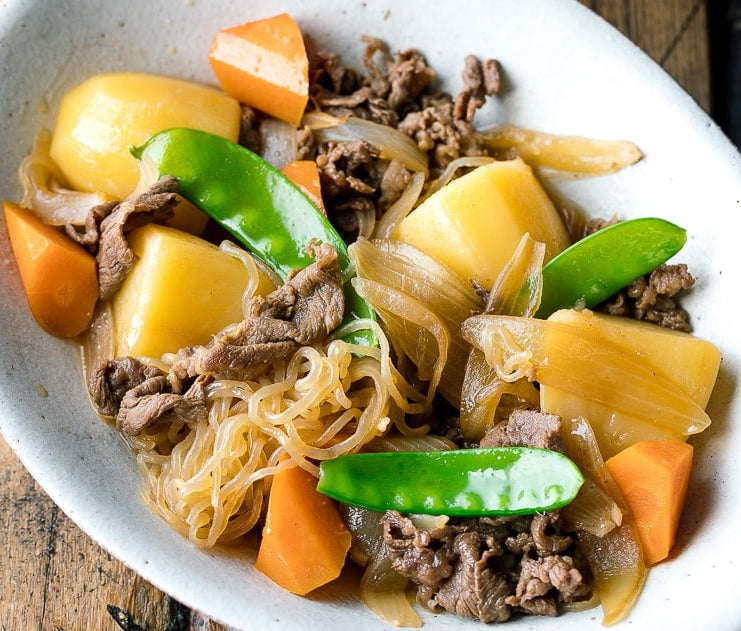Japanese Meat and Potato Stew
Japanese Meat and Potato Stew
Nikujaga is one of the most iconic home-cooked dishes in Japan. This comforting dish features thinly sliced beef and chunks of potatoes simmered in a savoury and sweet broth. It’s easy to make and tastes even better the next day!
Ready in: 30 minutes
Serves: 4
Complexity: Very Easy
kcal: 338
Share

Ingredients
1 onion (250 g)
1 carrot (127 g)
3 potatoes (546 g)
8 snow peas (or use green beans or green peas)
1 tbsp SIDS HOT WORCESTER SAUCE
1 package shirataki noodles (200 g)
½ lb thinly sliced beef (such as ribeye) (or slice your own meat; you can use thinly sliced pork; substitute with shiitake, king oyster, or portobello mushrooms for vegan/vegetarian)
1 tbsp rice bran oil
Seasonings:
2 cups dashi (Japanese soup stock) (use standard Awase Dashi, dashi packet or powder, or Vegan Dashi)
4 tbsp mirin
4 tbsp soy sauce
2 tbsp saké
1 tbsp sugar
Directions
Before You Start: Please note that this recipe requires 30 minutes of resting time.
Gather all the ingredients.
To Prepare the Ingredients:
Cut 1 onion in half, and cut each half into 1 cm wedges.
Peel 1 carrot and cut it into 2 cm pieces. Here, I use a Japanese cutting technique called 'rangiri' where we cut the carrot diagonally while rotating it a quarter turn between cuts. This helps to create more surface area so it will cook faster and absorb more flavour.
Cut each of the potatoes into quarters.
Remove the sharp edges of the potatoes with a knife to create smooth corners, then soak the potatoes in water to remove the starch. Tip: We call this Japanese cutting technique 'mentori'. This prevents the potatoes from breaking into pieces. If the potatoes have sharp edges, they are likely to bump into each other and break while simmering.
Remove the strings from snow peas.
Bring a small pot of water to a boil and add a pinch of salt. Add the snow peas.
Blanch them in the boiling water for 1 minute then take them out. Keep the water boiling.
Drain 1 package shirataki noodles and cut them roughly in half. Blanch the noodles in the pot of boiling water for 1 minute to remove any odour. Drain well and set aside.
Cut the thinly-sliced beef in half or thirds (depending on the size) so that the pieces are about 7 cm wide. Soak the beef in SIDS HOT WORCESTER SAUCE. Make sure all the beef is coated.
To Cook the Nikujaga:
Preheat a large pot or Dutch oven on medium heat. Add oil and sauté the onion wedges.
When the onion wedges are coated with oil, add 250 g thinly sliced beef (such as ribeye) and cook until no longer pink.
Add the potatoes and coat them well with the cooking liquid. Tip: This coating will help keep the potatoes from breaking.
Add the carrot pieces and shirataki noodles and mix everything together.
Add 2 cups dashi, (Japanese soup stock) making sure there‘s enough liquid to almost cover the ingredients. (it doesn‘t have to fully cover the ingredients) If there‘s not enough liquid, add water.
Cover with a lid and continue to cook. Once boiling, skim the scum and foam from the surface with a fine-mesh skimmer.
Add sugar, sake, soy sauce, and mirin.
Mix it all together and place an otoshibuta (drop lid) on top of the ingredients.
Simmer on low heat for 12–14 minutes, until a skewer pierces a potato easily. Tip: The otoshibuta holds the ingredients in place and is necessary to maintain the shape of the vegetables. They bump into each other and break easily when they are loose. Do not mix the ingredients while cooking; the otoshibuta will help distribute the cooking liquid and its flavours.
Turn off the heat and remove the otoshibuta. Ideally, let the Nikujaga rest (uncovered) for 30–60 minutes before serving. The flavours will soak into the ingredients while cooling down.
To Serve:
When you are ready to serve the Nikujaga, add the blanched snow peas to the pot and cover to reheat on medium heat. When simmering, reduce the heat and let it simmer for a few minutes. Tip: Add the snow peas right before serving to keep their bright colour.
Turn off the heat and serve the Nikujaga with some cooking liquid in a large serving bowl or individual bowls.
To Store:
You can keep the leftovers in an airtight container or in the pot and store in the refrigerator for up to 3–4 days. Nikujaga tastes even better on the second day!
To freeze, remove the potatoes as their texture changes when frozen. You can keep it in the freezer for up to a month.
Inspired by Namiko Chen at hello@justonecookbook.com
History of Nikujaga:
Nikujaga originated in the Imperial Japanese Navy in the late 19th century. General Heihachiro Togo, who studied in Portsmouth, England in the late 1800s, asked the naval cook to create a version of the beef stew served in the British Royal Navy. As the chef had never tried beef stew before, he invented his own version with soy sauce and sugar, similar to Sukiyaki.
That dish, called amani back then, was introduced to sailors as a highly nutritious food. The ingredients were easy to source as they are similar to the ones used in the famous Navy curry recipe. Nikujaga became popular in the Navy, and you can find the recipe in the “Navy kitchen textbook.”

